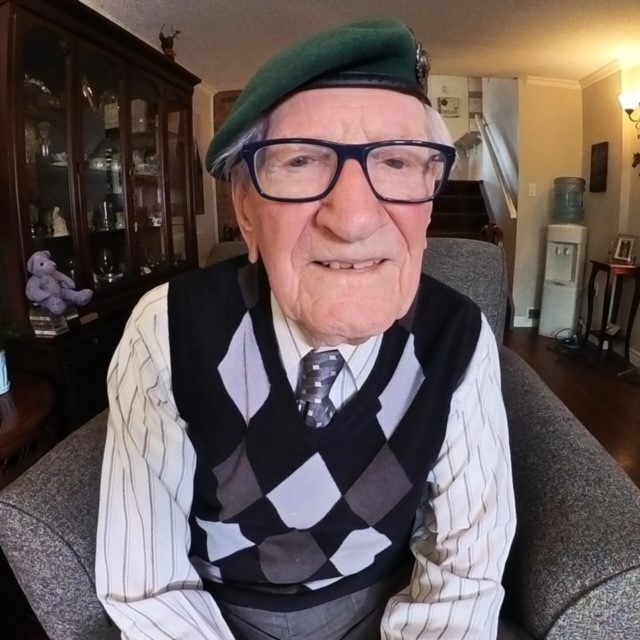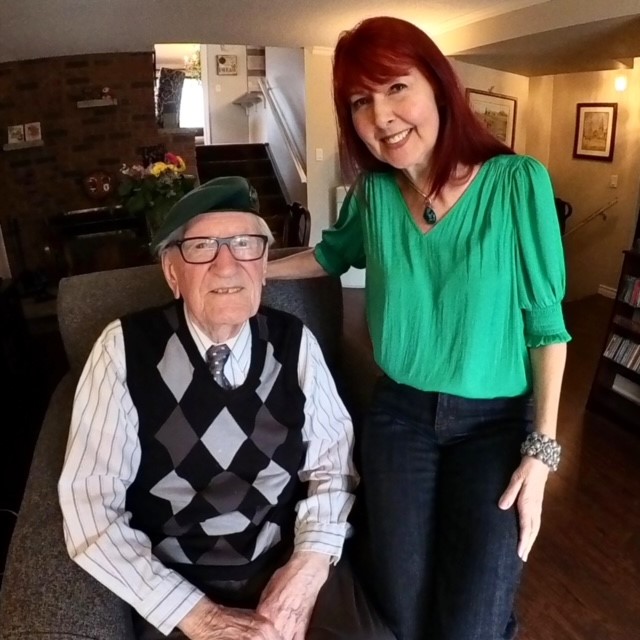The motorcycles had filled up a long stretch of parking in the southwestern Ontario town of Tillsonburg, long enough that then-98-year-old Tom Boneham and his caregiver/friend Christine Grim had to walk around them.
Boneham noticed a patch on one of their jackets that said “30 Commando.”
“I’m in charge of 30 Commando,” he recalled telling them. “I’m one of the originals.”
And that, in fact, was true. British-born Boneham, who has lived in Canada since 1952, was one of the 35 original members of the top secret commando unit created by James Bond author Ian Fleming known as 30 AU (assault unit).
One of the bikers called inside to his friends and then one by one they lined up and shook his hand. How often do you get to meet one of the original James Bonds?
Tom Boneham was just 19 when he learned of a new unit being formed in the British Army in late 1942. Not much was known of it other than it was “hazardous.” For a young Brit at the height of the Second World War, it wasn’t much of a deterrent.
“I was a teenager looking for adventure,” he said with a laugh. “It sounds good!”
Read more:
‘It’s a matter of training and confidence’: Calgary WWII veteran celebrates 100th birthday
What he didn’t know was how exclusive a unit it would turn out to be. The commanding officer was none other than Ian Fleming, who would later become famous for creating the British spy James Bond. Not that many in the unit even knew Fleming by name.
By design, none of the commandos serving in the unit knew the real names of their commanding officers.
“We used to call him the madman,” Boneham says. “We didn’t know it was Fleming, but they used to say, ‘The madman’s got something for us to do now.’”
Much of what Fleming cooked up for his commando unit would end up in the pages of his novels, albeit with different names. The 30 AU was disbanded after the war and declared top secret. It would be 50 years before much of what the unit accomplished was released to the public.
That didn’t stop Fleming from inserting Easter eggs into his work. It wasn’t a coincidence he chose the name “Goldfinger” for one of his books — AU is the symbol for gold on the periodic table.
“In From Russia With Love, the code machine that he’s trying to get off the Russians is obviously based on an Enigma machine,” 30 AU historian Dave Roberts recently told Global News from Southport, England. “But when he was writing, the Enigma secret hadn’t come out so, you know, people weren’t putting two and two together.”
The original 30 Fleming recruits (there would be 450 by the end of the war) soon learned their training would be unorthodox. While they learned general commando skills like weapons training and demolitions, they were also exposed to safecracking, interrogation techniques and parachute training, to name a few.
“We were told you won’t shoot your way in, but you’d be prepared to shoot your way out,” says Boneham.
“Their job was to seize radio stations, to seize HQs and basically take anything that was there,” says Roberts. “So any equipment, any code books, any technical data, any prisoners, it was their job to capture them before the Germans could destroy it.”
Boneham says they took pride in their newly-acquired skills and soon earned the nickname “the pinch unit” for their ability to steal. However, not everyone was a fan.
“They tended to always end up on the wrong side of U.S. General George Patton,” says Roberts. “He always got very upset with them. He referred to them as ‘pirates’ at one point and referred to them as ‘limey gangsters’ at another point.”
In 1943, Fleming’s commandos were called upon to use their particular set of skills to gather intelligence during the invasion of Sicily.
“We could just see a trickle of smoke from Mount Vesuvius and we were so eager to see the volcano,” says Boneham. “And the guy said, ‘You won’t see that until you fight your way there!’”
He never got the chance.
He doesn’t remember much other than the fact he was shot in the shoulder. When he awoke he was on a hospital ship. All of his belongings, including his father’s First World War journal, had been left behind. He had no feeling in his lower right arm after being hit by — he was told — a German sniper bullet.
By the time he had convalesced, his unit was too involved in the war for him to rejoin.
“He was so badly injured that he was brought back to the UK and by the time he comes out of hospital,” says Roberts, “30 Commando are all basically in lockdown ready for D-Day and he can’t get in touch with anyone because it’s top secret and they’re not allowed any communication. And that was that. His war was over.”
He didn’t know it at the time but he’d never see anyone from the 30 AU again. Boneham says the secrecy within the unit was so extreme they weren’t allowed to take pictures nor did they know anybody by their real names. He knew his friends as “Ginger” and “Lofty,” which made it difficult to find them post-war.
By 1952 he had moved to Canada where he met his future wife. That, coupled with the secrecy surrounding the unit, made him even harder to find.
After his wife died in 1994 he befriended his neighbour, Christine Grim. They became such good friends that when she asked him to move to Tillsonburg with her, he accepted. After all, they were both extroverts who enjoyed pubs and meeting new people, so why not?
And it was Grim, whose family was heavily involved in the Dutch resistance during the war, who posted in 2020 that she knew a veteran of the 30 AU during an internet chat that eventually caught the eye of Roberts and Canadian historian David O’Keefe.
When they first met, O’Keefe says he asked Boneham about the friendly fire incident that ended his war. Boneham, he says, was completely shocked.
For close to 80 years he had lived with the knowledge a German sniper had shot him. But O’Keefe had found a reference to Boneham in a book published in the 1990s that described how another soldier hadn’t discharged his weapon properly before cleaning his gun.
Today, Boneham says he has no interest in knowing who was responsible.
“No, no. Because that’s a buddy of mine, I wouldn’t want to know because we were all just great friends,” he says.
Roberts says they now believe Boneham is the last living member of Ian Fleming’s 30 AU.
Another veteran who was suffering from severe dementia is believed to have passed away a year ago. That didn’t go unnoticed by active British commando units in the UK who had hoped Boneham could attend a recent reunion for the families of the 30 AU vets that took place in England.
But while Boneham’s mind is as sharp as ever, he now walks with a cane.

Tom Boneham lost his unit beret when he was shot during the Invasion of Sicily in 1943. He’s wearing a beret gifted to him by an active 30 Commando Royal Marine.
Mike Drolet
Undeterred, three active members of the 30 Commando Royal Marines (named after the 30 AU) travelled to Tillsonburg as a surprise for Boneham’s 100th birthday. They gave him a statue of commandos wearing the uniforms of the 30 AU and when one of the Marines learned Boneham lost his unit beret when he was shot in 1943, he gave him the beret off his own head.
It was the closure Boneham didn’t know he needed.
“I just felt as if those three had been with me 80 years ago that we’d all be together,” he says. “That’s how I felt (about the brotherhood of the unit). And I still do.”

Former Commando Tom Boneham and caregiver/friend Christine Grim at their home in Tillsonburg, ON.
Mike Drolet
 Asian Tribune Your Multilingual Newspaper covering World and local news News
Asian Tribune Your Multilingual Newspaper covering World and local news News



